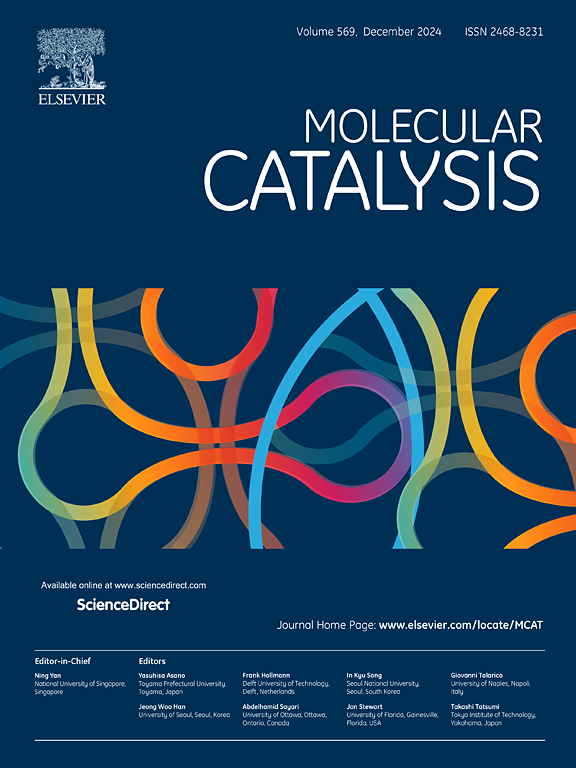Alkali-enhanced oxygen vacancies driven high catalytic performance of Pd/WO3 for selective hydrogenation of phenol to cyclohexanone
IF 3.9
2区 化学
Q2 CHEMISTRY, PHYSICAL
引用次数: 0
Abstract
Production of cyclohexanone through selective hydrogenation of phenol under mild conditions has attracted much attention. Herein, a NaOH-modified Pd/WO3 rich in oxygen vacancies for selective hydrogenation of phenol was prepared through impregnation method. The highest catalytic activity was exhibited on NaOH-Pd/WO3 with 25 wt % addition of NaOH, and phenol achieved 100 % conversion at 90 °C and 0.7 MPa H2 for 2 h, with a cyclohexanone selectivity of 95.3 %. The turnover frequency (TOF) of NaOH-Pd/WO3 is approximately 3.5 times higher than that of the Pd/WO3. Detailed catalyst characterization and theoretical calculations reveal that the high activity and selectivity of NaOH-Pd/WO3 for phenol hydrogenation to cyclohexanone are highly correlated with the concentration of oxygen vacancies in the catalyst. In-situ infrared and Raman analyses reveal that the OH- introduced by NaOH reacted with the lattice oxygen in WO3 to abstract oxygen from the lattice, generating a significant number of oxygen vacancies. The possible reaction mechanisms for phenol hydrogenation were elucidated through combined density functional theory calculations and isotopic labeling experiments. This strategy of improving catalytic activity and selectivity by regulating the concentration of oxygen vacancies provides a theoretical basis for the design and optimization of industrial catalysts.

碱增强氧空位驱动Pd/WO3对苯酚选择性加氢制环己酮的高催化性能
苯酚在温和条件下选择性加氢生产环己酮已引起广泛关注。本文通过浸渍法制备了一种富氧空位的naoh修饰Pd/WO3,用于苯酚的选择性加氢。NaOH添加量为25wt %时,苯酚对NaOH- pd /WO3的催化活性最高,在90℃、0.7 MPa H2条件下反应2 h,苯酚转化率达到100%,环己酮选择性为95.3%。NaOH-Pd/WO3的翻转频率(TOF)约为Pd/WO3的3.5倍。详细的催化剂表征和理论计算表明,NaOH-Pd/WO3对苯酚加氢制环己酮的高活性和选择性与催化剂中氧空位的浓度密切相关。原位红外和拉曼分析表明,NaOH引入的OH-与WO3中的晶格氧发生反应,从晶格中抽出氧,产生大量的氧空位。通过密度泛函理论计算和同位素标记实验,阐明了苯酚加氢的可能反应机理。这种通过调节氧空位浓度来提高催化活性和选择性的策略为工业催化剂的设计和优化提供了理论依据。
本文章由计算机程序翻译,如有差异,请以英文原文为准。
求助全文
约1分钟内获得全文
求助全文
来源期刊

Molecular Catalysis
Chemical Engineering-Process Chemistry and Technology
CiteScore
6.90
自引率
10.90%
发文量
700
审稿时长
40 days
期刊介绍:
Molecular Catalysis publishes full papers that are original, rigorous, and scholarly contributions examining the molecular and atomic aspects of catalytic activation and reaction mechanisms. The fields covered are:
Heterogeneous catalysis including immobilized molecular catalysts
Homogeneous catalysis including organocatalysis, organometallic catalysis and biocatalysis
Photo- and electrochemistry
Theoretical aspects of catalysis analyzed by computational methods
 求助内容:
求助内容: 应助结果提醒方式:
应助结果提醒方式:


